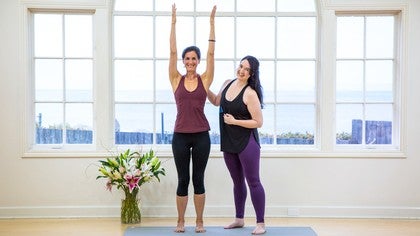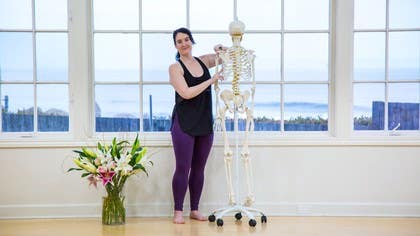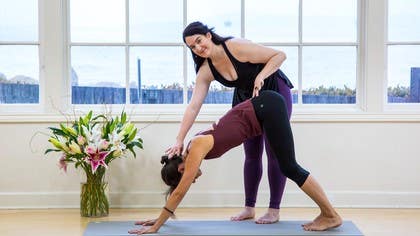Description
About This Video
Transcript
Read Full Transcript
So, we're very lucky we have Linda Baffa with us again to help us understand this glenohumeral rhythm. So, thank you. You're welcome. So, when we are, if you've ever had, I wonder if you've ever had this pain, let's turn to the back here, if we've ever had that pain that's kind of this mysterious deep pain in between one or two of your shoulder blades that you kind of want to like dig a block into or have someone dig an elbow into and it just never seems to go away. It's kind of a sensation that a lot of yogis are familiar with and it's one of the signs of this improper, inelegant dance between the glenohumeral rhythm or the scapula and the arm movement in our practice.
So, let's take a look at a really common move we do in yoga asana and how we might make it a little bit more fluid and dance like, yeah? Okay. So, I'll have you turn around. All right. So, first starting in what most of us starting in tadasana, again, we get so good at tadasana that we bring our shoulders out to the side kind of almost like we're in between two planes of glass for some bizarre reason, you find yourself between two planes of glass.
And then sometimes when we take the arms up into urdhva hastasana, we almost do this kind of move of the arms back behind us, kind of sweeping them up or straight out to the side. Let's take a look at what happens when we do that. So, if you were to take your arms out to the side like a good yogi and take your arms up, all of a sudden she has all of this tension in her upper shoulders, the upper trapezius, the deltoid, some of her neck muscles, and then a teacher trying to make her, you know, feel better and look a little happier will say, draw your shoulders down the back. Now, she can try that, she can do that a little bit, but what that is is dysfunction, dysfunctional glenohumeral rhythm. That's where that pain kind of comes from.
So, that's unfortunate and we don't want to encourage that, so let's try a different way. I'll have her lower her arms and then just kind of come to like a neutral stance. She hopefully looks like a little bit more at peace, a little bit more at ease. Her breastbone is kind of softening inwards, her front ribs are softening inwards, her front body soft, permeable, present. Shoulders are at a little bit of an angle forward and now she's going to move from tadasana to urdvahastasana, but I like to think of it as keeping her thumbs in her peripheral vision.
So, they're a little on the forward plane, not directly out to the side, she'd be running into that glass pane in front of her if it was still there. Now, she can take her arms up, her scapula is upwardly rotating, she has a little bit of elevation in her scapula, but look how much more space and ease, right? Her neck is softer, she has a little softer smile on her face, all around more freedom, more ease. So, this might be a sweeter way, now I don't feel the need as a teacher to go, draw your shoulders down your back, draw them down the back, and I don't cause some injury or dysfunction to occur. So, I'm going to have you lower your arms, now this is the same exact move when we're doing our sun breath, so the inhale urdvahastasana, exhale folding forward, coming back up, sometimes we call it the swan dive, coming back up, and then back to tadasana, so I'm going to have her do it first with this kind of 180 degrees or kind of really exaggerated pose, and just kind of watch what happens, so as she comes up, now she's got to use all of these muscles, a little tension in her neck and jaw, and then as she dives forward, she's kind of disconnecting her thoracic spine, her throat, her neck, she looks like she's swan diving, right, but it's not the best biomechanically, and then she's going to reverse her swan dive, kind of breaking her neck and chest, and a lot of tension, and then tadasana.
So instead, maybe we try with the elegance of the body and how it intuitively, intelligently moves, we'll move from that neutral spot, inhale urdvahastasana, the breath filling, inviting space and elegance, exhale fold forward, thumbs will stay in the peripheral, a sweeter alignment between the head and heart, inhale keeping the thumbs in the peripheral as you sweep all the way up, space and grace, exhale tadasana, happier, give it a try, let me know how it goes.
Your Body on Yoga: Upper Appendage
Comments
You need to be a subscriber to post a comment.
Please Log In or Create an Account to start your free trial.












